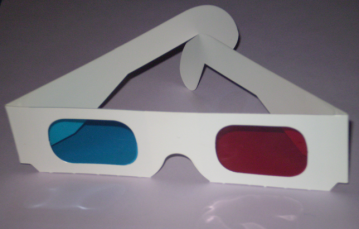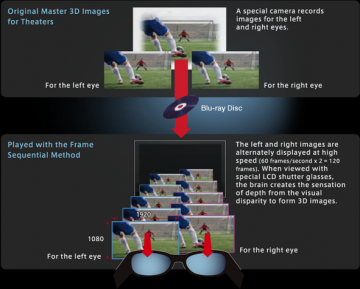September 25, 2009 weblog
Active Shutter 3D Technology for HDTV

(PhysOrg.com) -- Sony and Panasonic have recently announced a new technology, called "active shutter" for producing the experience of 3D on high definition TVs. The first models are expected to be available in late 2009 or early 2010.
The original 3D experience of movies depended on the viewer wearing stereoscopic green and red glasses. The illusion of 3D in the image came from superimposed green and red images taken from slightly different angles. Each eye saw only one image, and the viewer's brain combined them to give the illusion of three dimensions. 3D movies using this technology, called anaglyph 3D, can be viewed on any TV, as long as the viewer wears the glasses.

The problem with anaglyph 3D is that it strains the eyes, and can cause headaches and nausea in some people. Others have a dominant eye, and find it difficult to see the image as three dimensional.
A newer process for 3D in the cinema uses a special screen and polarized glasses. In this system images for the left and right eye are rapidly alternated, and the glasses pick up the appropriate image for each eye. A similar technique has now been introduced for high definition LCD televisions by LG Electronics in South Korea and Hyundai in Japan. The system, known as X-Pol, projects the different images in the even and odd horizontal lines of the video, and the polarized glasses sort it all out for the viewer.

Now Sony and Panasonic have introduced an "active shutter" technique for high definition plasma and LCD TVs. The viewer still has to wear polarized glasses, but in this system the glasses have LCD active shutters that are synchronized with signals from the TV. The shutters rapidly block the right and left eye views alternately so each eye receives the correct image.
The new system gives higher resolution than X-Pol because in active shutter technology each eye sees all the lines in the video, whereas in X-Pol each eye sees only half the lines.

Panasonic executive Peter Fannon said the new high definition 3D televisions will give viewers an experience just like being there, rather than watching it on TV.
Panasonic will be releasing some Full HD 3D models later this year, with Sony's version coming on the market later. Buyers of the new TVs will also need 3D-compatible Blu-ray disc players. The glasses will be supplied with the TV sets. There is no information yet on the prices of these televisions.
More information:
• Video: CES 2009: Panasonic 3D HD TV
• Video: CES 2009: Panasonic TVs and portable Blu-ray
• Video Commercial: Sony's first 3D Home TV's coming in 2010
• www.panasonic.com/3D/
© 2009 PhysOrg.com

















